Protecting & Restoring Long Island's Peconic Bays
The Peconic Estuary's unique shallow and deep water zones, formed over thousands of years, provide habitat for a range of plant and animal species.
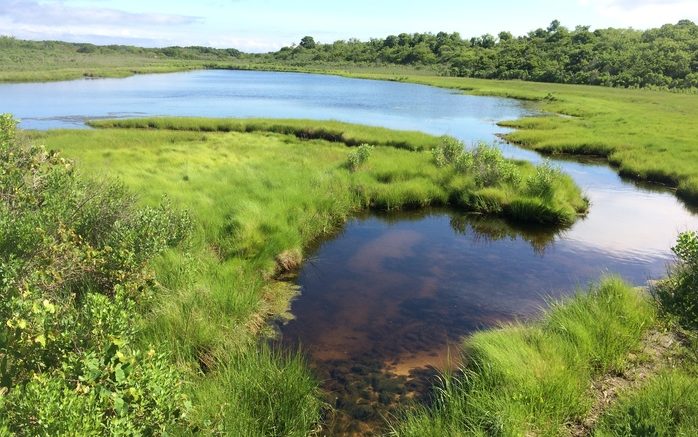
The Peconic Estuary was formed by the advance and retreat of the Wisconsin glacier, as well as other weathering and erosional forces. The glacier left two moraines that separate to form the Peconic Estuary. The Ronkonkoma Moraine makes up the central and South Fork sections of Long Island, while the Harbor Hills Moraine makes up the north shore and north fork of Long Island.
The series of bays that make up the Peconic Estuary are fairly shallow, with depths ranging from 14 to 90 ft. deep. The areas surrounding the Estuary are rich with scenic beaches, creeks, wetlands, and woodlands.
Within the Peconic Estuary Study Area, there is a larger percentage of undisturbed habitats and a greater diversity of natural communities than anywhere else in the coastal zone of New York State. There are over 100 species that are rare or endangered globally, nationally, and locally. Additionally, there are individual habitats in the region that are rarely found elsewhere in New York State or on the east coast of the United States.
On the following pages, you can learn more about the living resources that are found in each zone of the Peconic Estuary:
The deep-water zone is the portion of the estuary that has a water depth greater than three meters (approximately 10 feet). These open waters of the Peconic Estuary include most of Flanders, Great Peconic, Little Peconic, Noyack, Southold, and Gardiners Bays; portions of Northwest and Orient Harbors; and Shelter Island Sound.
The deep, open waters contain a large portion of the adult fish that are harvested commercially or recreationally in the Peconic Estuary System. These waters are also an important nursery area for many species of fish, such as tautog, weakfish, scup, winter flounder, bay anchovy, Atlantic silversides, butterfish, bluefish, and northern puffer. Many of these species are found at locations throughout the estuary and may seasonally or diurnally move back and forth between the deep and shallow water zones.
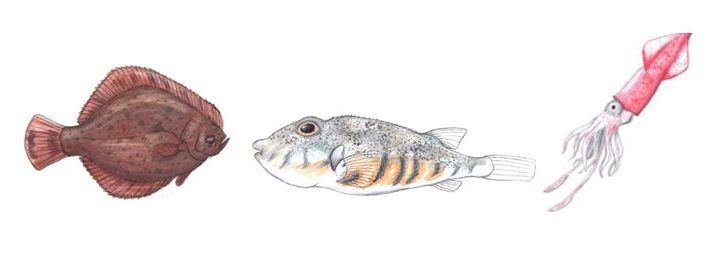
A number of invertebrates live in the deep water zone, including green, lady, and blue crabs, spider crabs, horseshoe crabs, mantis shrimp, long-finned squid, channeled and knobbed whelks, slipper shells (locally called quarterdecks), blood arks, oyster drills, and jingle shells. Additionally, on the mud bottoms, there are dense mats of tubes built by polychaete and oligochaete worms. These and other bottom burrowers, like the mantis shrimp and brittlestar, help to circulate oxygenated water into the oxygen-depleted mud sediments of the deep Peconic bays.
The deep-water zone is used by a variety of birds for feeding, notably sea ducks such as red-breasted mergansers, three species of scoters (Melanitta perspicillata, fusca, and nigra), and common eiders. Sea ducks are so-called because they feed and rest in deep, open coastal waters and rarely, if ever, come to shore. The sea ducks do not breed and rear their young in the Peconic system but use it exclusively as an over-wintering site. These waterfowl are found in high concentrations during the early months of the year at a number of sites. They feed primarily on shellfish such as blue mussels and other bottom dwelling invertebrates.
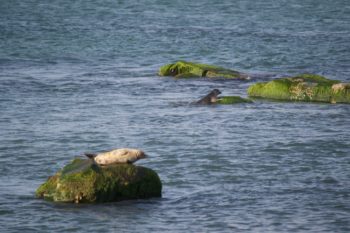
Several threatened or endangered sea turtles and a number of protects cetaceans, (whales, dolphins, and porpoises) and pinnipeds (seals) can also be found seasonally in the deep water zone of the estuary. Juvenile loggerheads, Kemp’s ridleys and green sea turtles may enter the Estuary from late spring to early fall to feed. Kemp’s ridleys, the most endangered of all sea turtles, primarily feed on spider crabs. Loggerhead turtles, the most abundant in our area, also feed on spider crabs, as well as other crabs and mollusks. Green turtles are strictly vegetarian, feeding on a variety of aquatic vegetation. The most common species of pinnipeds found in the Peconic are harbor seals. Less common are the harp seals and grey seals. These seals are found in association with a number of haul-out areas around the eastern Peconic Estuary and Block Island Sound. During the spring and summer months, harbor porpoises, bottlenose dolphins, and minke whales may enter the Estuary. They follow their food source, primarily herring and squid, into our coastal waters.
This zone is defined as those waters in the main bays with a depth of less than three meters (approximately 10 feet) and the portions of tidal creeks, ponds, and large embayments in the Peconic Estuary that remain submerged through the tidal cycle.
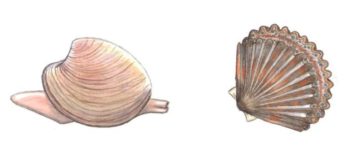
The shallow water zone of the estuary is crucial for local populations of breeding fish. Some species of adult finfish move in close to shore to spawn and reproduce (e.g., weakfish, winter flounder, and Atlantic silversides). Others spawn in the ocean and the larvae move inshore, metamorphose, and the juveniles feed in the shallow areas until they are large enough to migrate back offshore (e.g., bluefish, summer flounder).
Additionally, the shallow water zone supports the majority of commercially harvested shellfish, including the iconic bay scallop and the hard clam.
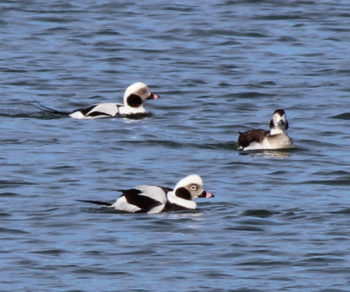
There are more birds feeding in the shallow water zone than in the deep-water zone. Birds in this zone consist of waders, such as herons and egrets, and waterfowl such as puddle and bay ducks. Puddle ducks (also called dabbling ducks) are usually found in shallow embayments and frequently feed on land as well as in the water. Black ducks and mallards are examples of puddle ducks. Bay ducks are similar to sea ducks in that they spend most of their time offshore, but they remain in fairly sheltered embayments. Shorebirds (e.g., least tern and roseate tern) also depend on fish in these areas for food.
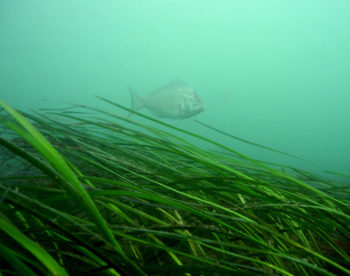
Most of the beds of submerged aquatic vegetation are found in the shallow water zone. Submerged aquatic vegetation is defined as beds of rooted vascular plants or macroalgae, both of which require complete immersion for all or most of the day to survive. Submerged aquatic vegetation, particularly eelgrass, is of great ecological importance in shallow environments. Eelgrass beds provide shelter and food for a variety of juvenile finfish and invertebrates, most notably juvenile bay scallops which attach to the eelgrass blades. Shelter is provided not only by the actual structure of the eelgrass blades but also by the fact that eelgrass beds slow currents. These rooted plants stabilize the underlying substrate and prevent scouring and erosion. Current eelgrass beds are found around Shelter Island and to the east along the fringes of Gardiners Bay and within a few small embayments and creeks.
Macralgae beds are generally considered poorer habitat compared to eelgrass. Since macroalgae are not rooted, they do not stabilize soft bottoms. Rather, they are easily uprooted and can be carried some distance where they foul eelgrass beds, beaches, and bare bottoms. The macroalgae species that occur in greatest abundance are green fleece, an invasive species, and sea lettuce. Fishermen have reported bay scallops in areas of green fleece in the western portion of Peconic Bay.
This zone includes all areas around the edge of the estuary that are periodically inundated by tides or impacted by storm surges. Habitats in this zone include salt marshes, mud and sand flats, and beaches. This zone is home to a wide variety of organisms, which are adapted to the daily tidal fluctuations. There is an entire invertebrate community, which is associated almost exclusively with the intertidal area. Organisms found only in these areas include several species of snails and bivalves, fiddler and other crabs, various species of polychaete and oligochaete worms, and a huge variety of microorganisms.
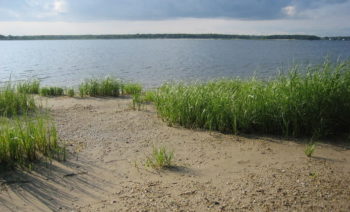
Salt Marshes are vegetated areas around the edge of the estuary. They are inundated by seawater brought in by the tides twice-daily. The low marsh is dominated by salt marsh cordgrass (Spartina alterniflora), a plant that is specially adapted to living in this unique environment. The high marsh, which is only inundated by seawater during the highest spring tides or storm surges, is usually dominated by salt meadow grass (Spartina patens), but may contain a variety of other plants too.
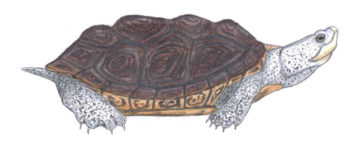
Marshes play an important role in estuarine ecology and are some of the most productive habitats on Earth. They are ideal habitats for juvenile fish and invertebrates to grow and reproduce. In fact, 3/4 of the fish and shellfish we eat rely on the marsh environment at some point during their life! Salt marshes are also important areas for waterfowl and shorebirds, and are home to the diamondback terrapin, an exclusively estuarine reptile. Diamondback terrapins live in the marsh, but lay their eggs in soft sand, usually at the upper margins of the marsh and beaches.
Beyond serving as important habitat for a number of species, marshes stabilize the shoreline and provide a critical buffer between the estuary and terrestrial environment. These habitats are capable of filtering a large amount of surface runoff from land, buffering the estuarine waters from excess nutrients and contaminants that might be contained in surface runoff. Conversely, salt marshes can absorb a large amount of floodwater from the estuary, providing protection to coastal communities during larges storms.
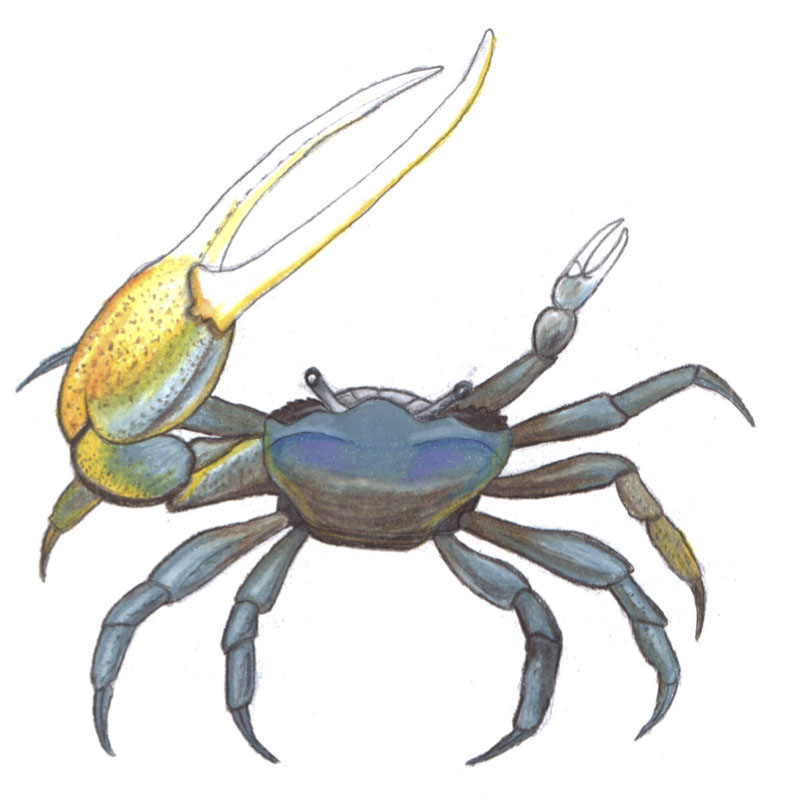
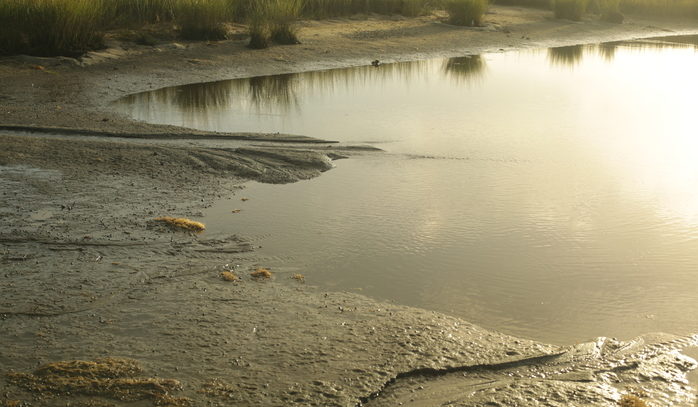
Tidal flats are unvegetated intertidal areas consisting of mud or sand. These areas are often covered by algae. Animals that live in tidal flats include several commercially important bivalves, such as clams, as well as crabs, snails, and worms. One of the most sighted animals on tidal flats in the Peconic is the fiddler crab. These areas may also be used by finfish for spawning and nursery grounds with the adults, larvae, and juveniles moving on and off these unvegetated areas with the tides. These estuary margins are extremely important to birds. Wading birds and raptors feed over the mud and sand flats at high tide.

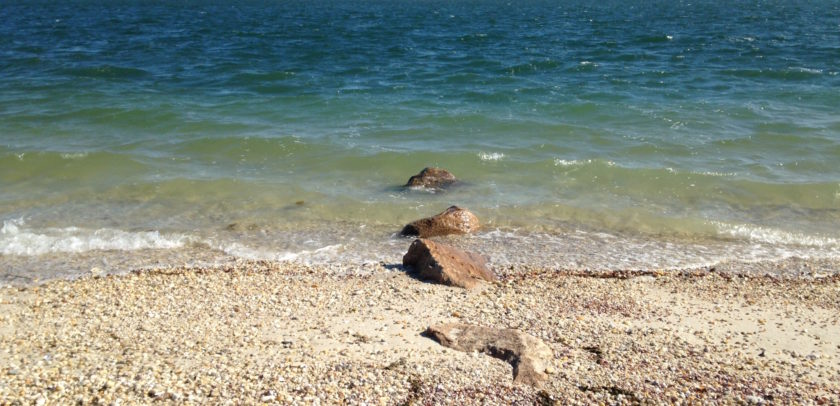
Sandy beaches are found throughout the Peconic Estuary system. Beaches are dynamic environments that are continuously being accreted and eroded by waves, wind, and currents. Dunes or bluffs form on the landward side of some beaches.
The unstable and harsh environment of beaches limits the number of organisms that can live here. However, beaches are home to a variety of rare plants, such as the seabeach knotweed, that are exclusively adapted to these nutrient-poor environments. Many tiny animals live between the sand grains, and a number of species will feed on the beach wrack, the band of dead, washed up vegetation, shells, and other debris found near the high tide line. These environments provide important nesting habitat for two endangered shorebirds, the piping plover and roseate tern. Horseshoe crabs also move onto sandy beaches in the spring to breed.
The Peconic River flows west to east from the town of Brookhaven to Flanders Bay, the westernmost bay of the Estuary. It is the longest river on Long Island. There are also a number of small freshwater streams and creeks within the Peconic Estuary study area. The freshwater environment is crucial to the Peconic system, because it is the influx of fresh water that makes the system estuarine. A mix of fresh and salt water is vital for the growth and development of many species, some of which cannot survive in highly saline seawater.
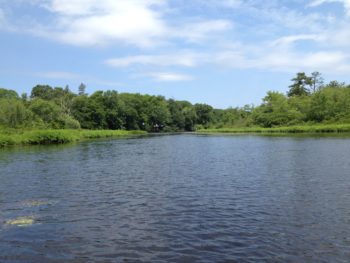
Additionally, a number of freshwater wetlands, coastal plain ponds, vernal pools, bogs, fens, and swamps occur within the Peconic Estuary Study area. These include the rare coastal plain poor fen and Atlantic white cedar swamp communities. As with salt marshes, these habitats absorb and filter stormwater runoff, and are therefore important for enhancing estuarine water quality.
The freshwaters habitats of the Peconic support a number of warm-water fishes, such as the largemouth bass, bluegill, sunfish, yellow perch, and white perch. The upper reaches of the Peconic River and connected fresh water ponds are home to two New York State threatened fish, the banded sunfish and swamp darter. The Peconic River and a few other streams in the region also provide critical habitat for diadromous fish that move between ocean and freshwaters, like river herring and American eel.
Additionally, the Peconic freshwater habitats support a number of other rare and endangered plants and animals, including various salamanders, frogs, turtles, and birds. The Peconic River basin and a few other surrounding ponds provide critical habitat for the State listed endangered tiger salamander.
The terrestrial zone starts landward of habitats that are inundated by tides but not including the Peconic River, freshwater wetlands, and ponds. There are a number of characteristic plant communities, which occur in this upland coastal zone around the Peconic Estuary. Soil type, hydrology, and microclimates determine the occurrence of these communities.
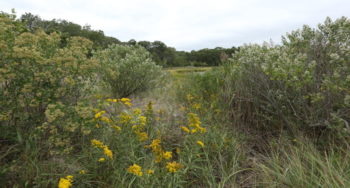
Forest types include maritime red cedar (found on the long, narrow peninsula of Orient State Park), maritime oak (found on the exposed bluffs of Jessups Neck and Mashomack Preserve), coastal oak-holly (on the Montauk peninsula), and the Long Island Central Pine Barrens. In the Pine Barrens, pitch-pine oak is the dominant plant community, but there are also rare dwarf pitch pine plain communities, which include pines and other co-dominant trees no greater than 3 meters in height.
Other significant coastal upland plant communities include remnant maritime grasslands (found in the Peconic Estuary at Conscience Point, Montauk, and the Shinnecock Hills) and maritime heathlands (found at Montauk Mountain). These communities consist of tall grasses and shrubs and are notable for their lack of large trees.
All these plant communities contain numerous insects, birds, and other organisms, which are specifically adapted to them. Many vascular plants and several birds and insects found in the terrestrial zone have been identified as threatened, endangered, or species of special concern.
Sign up for News, Events and Information straight to your inbox.
